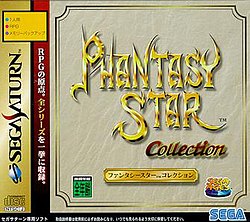Phantasy Star Collection
| Phantasy Star Collection | |
|---|---|

Japanese Box Art
|
|
| Developer(s) |
Sega (SS) Digital Eclipse (GBA) |
| Publisher(s) | Sega |
| Designer(s) |
Akinori Nishiyama and Rieko Kodama (writers / directors) Yuji Naka (producer / programmer) |
| Series | Phantasy Star |
| Platform(s) | Sega Saturn, Game Boy Advance, PlayStation 2 |
| Release date(s) |
Sega Saturn
|
| Genre(s) | Role-playing video game |
| Mode(s) | Single-player |
| Aggregate scores | |
|---|---|
| Aggregator | Score |
| GameRankings | 76.1% |
| Metacritic | 76 out of 100 |
| Review scores | |
| Publication | Score |
| EGM | 8.2 out of 10 |
| Game Informer | 8 out of 10 |
| GamesMaster | 88% |
| GameSpot | 8.6 out of 10 |
| IGN | 6 out of 10 |
| Nintendo Power | 7.7 out of 10 |
| GMR | 9 out of 10 |
| Nintendojo | 9.3 out of 10 |
| Pocket Games | 9 out of 10 |
Phantasy Star Collection is the name of two different compilations of Phantasy Star games. The first, released for the Sega Saturn in Japan in 1998, featured the first four games in the series, whereas the Game Boy Advance version, released four years later in North America, only featured the first three. The North American version was produced by Digital Eclipse. The Saturn version was later ported to the PlayStation 2 in Japan with more games added.
Each compilation features ports of the original Phantasy Star games. They are virtually identical to their original versions, as opposed to enhanced remakes. Gameplay has not been altered in each of the collections.
Each game features overworld maps and separate dungeon areas, both with random encounters. Players control parties of characters, battling enemies and earning experience points to grow stronger. Certain characters can use different magic spells and techniques during and outside of battle. Phantasy Star's dungeons differ from the rest because they are in first-person, while the rest of the games use a top-down style.
Although each game in the collections feature different characters and stories, they take place in the Algol planetary system, specifically on the planets Palma, Motavia, and Dezolis. In the four games, there exists a Dark Force, a common antagonist that threatens the solar system. The games also make small references to each other, such as the idolation of Alis in Phantasy Star IV.
Its first incarnation was released in 1998 on the Sega Saturn, as part of Sega's Sega Ages series of classics that included Space Harrier, Out Run, After Burner, and Fantasy Zone. Although the former three games listed emerged in the West as a single compilation, Phantasy Star Collection remains a Japan only title. It included what is considered the main entries in the series, with select enhancements such as the option of playing the games in katakana or hiragana (they originally were katakana only), and an optional speed increase for party members in Phantasy Star III. Due to the native resolution of the Mark III, the original Phantasy Star is played in a frame. Omake features were also included with the game, such as exclusive arranged music, art galleries, and Japanese commercials.
...
Wikipedia
